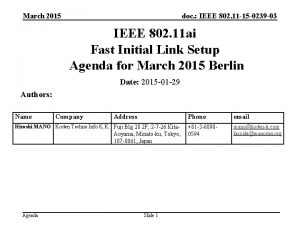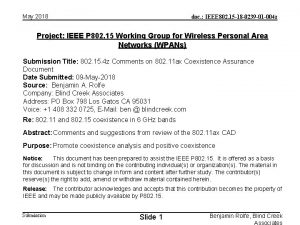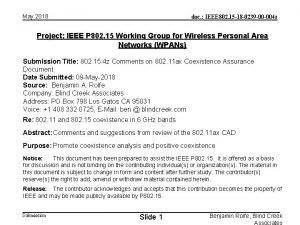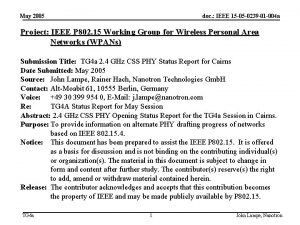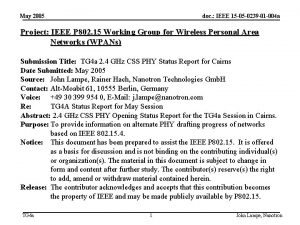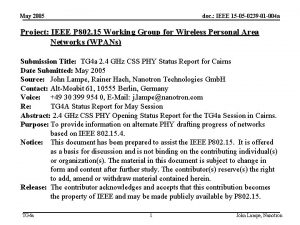Mar 2011 doc IEEE 802 15 11 0239









- Slides: 9

Mar 2011 doc. : IEEE 802. 15 -11 -0239 -00 -0006. Project: IEEE P 802. 15 Working Group for Wireless Personal Area Networks (WPANs) Submission Title: Proposed modification to IEEE 802. 15. 6 Turnaround time Date Submitted: 20 - Jan, 2011 Source: Peter Bradley, Didier Sagan, Rick Powell; Zarlink Semiconductor Re: Analysis of IEEE 802. 15. 6 p. SIFS Turnaround Timing & Requirements Abstract: This document analyses the p. SIFS Turn-Around Timing Sequence to assist in determining the necessary turn-around time requirements for the various bands. This relates to Comment S 7 -123 and S 7 -124 on Letter Ballot 66. Purpose: For discussion by IEEE 802. 15 TG 6 Notice: This document has been prepared to assist the IEEE P 802. 15. It is offered as a basis for discussion and is not binding on the contributing individual(s) or organization(s). The material in this document is subject to change in form and content after further study. The contributor(s) reserve(s) the right to add, amend or withdraw material contained herein. Release: The contributor acknowledges and accepts that this contribution becomes the property of IEEE and may be made publicly available by P 802. 15. Submission 1 Rick Powell, Zarlink Semiconductor

Mar 2011 doc. : IEEE 802. 15 -11 -0239 -00 -0006. p. SIFS Turnaround Time • p. SIFS: – Defines TX to RX and RX to TX turnaround time – Concerned that the time may not be adequate for very low power, small applications with comparatively small processing power – Inconsistent efficiency and processing time for different bands – Trade-offs • Too high a value – Inefficient dead-time introduced • Too low a value – May place demands on MAC processing that may be inconsistent with a very low power, small application – Recommend considering 7 symbols for RX filters, demodulators etc, then ~10 us for BCH and CRC and other PHY digital, followed by 5 symbols of PA Ramp-up time. – For MICS, this gives 74 us delay without MAC packet processing !! – This is very tight, and it is undesirable from a peak power perspective to have simultaneous TX and RX circuit operation. Submission 2 Rick Powell, Zarlink Semiconductor

Mar 2011 doc. : IEEE 802. 15 -11 -0239 -00 -0006. Turnaround Timing Consider example case for 900 MHz bands. The following slide illustrates a possible turn-around timing sequence in a 15. 6 transceiver. There are 2 devices shown, 1 & 2. The Rx to Tx Turn-Around is shown for Device 2. The common reference point for Turn-Around is at the Antenna, labeled: symbol@Antenna. Other Factors: • Symbol Period = 4 u. Sec • Antenna to Rx Digial Latency = 7 Symbol Period • PA Ramp-up and Ramp-down time = 5 Symbol Periods • Tx Digital to Antenna Latency = 5 Symbol Periods • The Last Symbol of the Frame is denoted as d[n] • The First Symbol of the Frame is denoted as fs[1] Submission 3 Rick Powell, Zarlink Semiconductor

Mar 2011 Submission doc. : IEEE 802. 15 -11 -0239 -00 -0006. 4 Rick Powell, Zarlink Semiconductor

Mar 2011 doc. : IEEE 802. 15 -11 -0239 -00 -0006. Turn-Around Decision • When a device receives a frame, it must decide whether or not to switch to Receive after receiving the frame (Rx to Tx Turn-Around) • This decision is based on several factors: § Frame Sub-Type of Frame Received § Setting of More Data bit in Frame Received § Acknowledge Type requested in Frame Received § Time remaining in the current Allocation Interval § Whether the Receiving Device has a Data/Management Frame to send § Whether the Frame is “Received” – Good FCS and Correct Header • If this information is not available and validated prior the time needed to start a Turn-around, then the Device must make its decision based on a “best guess” of what to do. • If the device makes the decision to Turn-Around when it should stay in receive, then it may miss the next frame. Submission 5 Rick Powell, Zarlink Semiconductor

Mar 2011 doc. : IEEE 802. 15 -11 -0239 -00 -0006. Turnaround Time • Examine turnaround time as percentage of packet length for 0 byte payload an 255 byte payload – Current proposal of 50 us p. SIFS has varying efficiency for each band with the 400 and 900 MHz bands having a much lower proportion of dead-time than 2. 4 GHz. – The lower symbol rate bands have longer packets so the turnaround time is a lower percentage of the overall transmission – This is inconsistent. – Delays in the Rx and Tx path will be proportional to the symbol rate. • Conclusion: It is reasonable to adjust p. SIFS for differing symbol rates Submission 6 Rick Powell, Zarlink Semiconductor

Mar 2011 doc. : IEEE 802. 15 -11 -0239 -00 -0006. Turnaround time relative to packet length Turn-Around time accounts for a small percentage of bandwidth inefficiency, typically 1 to 3% for Frame without Payload, and much less for Large Payload Frames, 0. 2% to 1%. Scheduling resolution accounts for 10 to 25% inefficiency: • Minimum Slot Size is 1 m. Sec • For a 1 second period Superframe with 256 slots, the slot size needs to be 4 m. Sec • An Allocation Interval is comprised of one or more slots. • On Average, one half on the last slot is unused. • If the Average Allocation Interval is 2 to 4 slots, then the inefficiency is 12. 5% to 25% • This is almost an order of magnitude greater than the inefficiency of the turn-around time. Conclusion: Increasing Turn-Around Time as needed will not have a large impact on overall Bandwidth Efficiency Submission 7 Rick Powell, Zarlink Semiconductor

Mar 2011 doc. : IEEE 802. 15 -11 -0239 -00 -0006. Current Turn-Around Times, Slowest Ack Frame Band Symbol Rate Symbol Time Symbol Delay 12 Symbols Turn-Around Time Available Digital Time Turn-Around Overhead 4 xx-4 xx 187. 5 5. 33 u. S 64 u. S 50 u. S (-14 u. S) 2. 7% 8 xx-9 xx 250 4 u. S 48 u. S 50 u. S 2 u. S 3. 5% 23 xx-24 xx 600 1. 67 u. S 20 u. S 50 u. S 30 u. S 4. 8% Proposed Turn-Around Times, Slowest Ack Frame Band Symbol Rate Symbol Time Symbol Delay 12 Symbols Turn-Around Time Available Digital Time Turn-Around Overhead 4 xx-4 xx 187. 5 5. 33 u. S 64 u. S 90 u. S 26 u. S 4. 7% 8 xx-9 xx 250 4 u. S 48 u. S 70 u. S 22 u. S 4. 8% 23 xx-24 xx 600 1. 67 u. S 20 u. S 50 u. S 30 u. S 4. 8% Submission 8 Rick Powell, Zarlink Semiconductor

Mar 2011 doc. : IEEE 802. 15 -11 -0239 -00 -0006. Turnaround Time • Turn-Around Time needs to consider the MAC decision requirements needed for Turn-Around. • If the Turn-Around decision is made before validating the header, there is a risk that the Device will miss the following Frame. This needs to be taken into account. • For consistent efficiency and allowance for delays, p. SIFS times should be proportional to symbol rate. • The following p. SIFS times are recommended: Submission 9 Rick Powell, Zarlink Semiconductor










